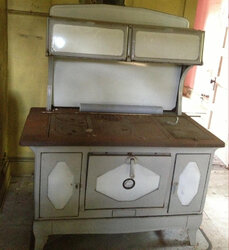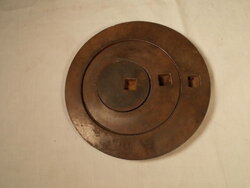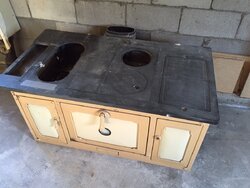OK, it's a range; If no legs, it's a cabinet style. Here are the parts missing;
There are 2 lids (or eyes) missing on the left. The two on the left get a center support piece between them. That could be the most difficult piece to find.
The front eye, or burner should be more than a one piece lid. A one piece lid will work, but I strongly suggest you find the proper "nest" that is multiple pieces to be able to control the size of the opening when lid is removed. It is far better to cook with lid removed so the heat from fire directly under it is in direct contact with the pan. Otherwise cooking is slow and no different than cooking on a wood stove top. By removing the smaller center portion, you have the least amount of area for smaller pots, kettle or less heat. Removing the outer ring enlarges the hole for larger pans. What you have now with both lids and center support removed is for laundry tub heating. Notice the long shape with rounded ends matches a laundry tub. (no smoke will leak out when lids are removed to cover with pans. The air pressure under cooktop is lower than atmospheric pressure due to the chimney draft - so air will leak in, decreasing the fire by cooling chimney decreasing draft. Smoke or products of combustion do not leak out)
Make sure the oven control flap is there, as well as any (coal) grates or firebrick in firebox. A picture with left door open will show if anything critical is missing.
Also be sure any lids you get have the little ears in the lifting hole. They are the first to wear off or break, and you need them to lift the lid when hot with lid lifter. They should match the ones you have on the stove, so only one lifter is needed. The support piece between lids will also have the lifting hole.
The top looks like it's in really good condition. Keep it oiled so it doesn't rust before you get it hot enough to season it. (Linseed) You will find many have different opinions on what type oil to use. Most don't know the science behind it. Any drying oil is OK. But some are better. When heated, the object is to polymerize the fat in the oil. This actually releases the free radicals to crosslink and form the hard coating which is a different molecular structure than the original oil. (there's no way to explain it without getting technical, but that's why the smoke point doesn't matter since this coating becomes a different substance then the original oil- notice the hard baked on stuff in an oven that is extremely hard to remove - this is polymerized fat that requires chemicals or a self cleaning oven to get hotter than cooking temperatures) Lard was originally used, but pigs had the proper diet and chemically it was correct for this use. Grain fed pigs today have less alpha-linolenic acid (ALA), which is what you want (high ALA) for good seasoning.
Notice in the picture of a different model below, there is an open type lid in the back. This is an adjustable "air leak" to allow air up the chimney to slow draft, like a barometric damper. It is used to bank the fire overnight for a longer duration fire. Not sure what yours uses for this. Easy way to figure out the operation; Any air admitted OVER the fire slows it down, UNDER the fire increases it.


3 piece nest. (possibly missing ears for lifting if it doesn't have a hole under left side of hole to hook under to lift with different type of lifter than yours) You can see how removing just the center allows less flame to the pan. Many times you use a smaller pan and a one piece lid is far too large. So you have to cook on the stove top. Cooking with direct flame contact is much faster than gas or electric. You move the food all the time like a wok or it burns quick. The heat with lids in place on the stove top is more like a medium to low heat, and you learn real quick where the cooler places are away from the firebox side for simmer or warming. The knack to stove top cooking is moving the pans to the heat desired, not controlling the heat of the burner as with modern ranges.




